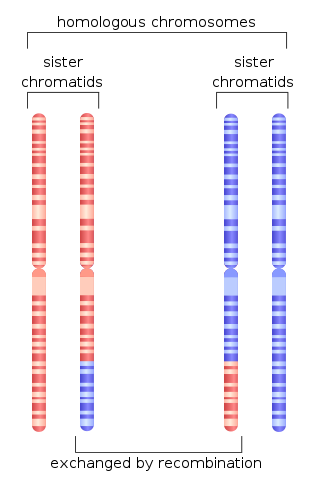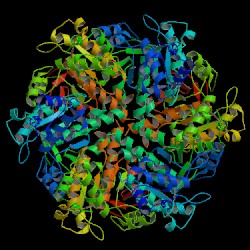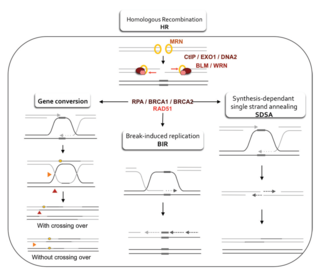Related Research Articles

Genetic recombination is the exchange of genetic material between different organisms which leads to production of offspring with combinations of traits that differ from those found in either parent. In eukaryotes, genetic recombination during meiosis can lead to a novel set of genetic information that can be further passed on from parents to offspring. Most recombination occurs naturally and can be classified into two types: (1) interchromosomal recombination, occurring through independent assortment of alleles whose loci are on different but homologous chromosomes ; & (2) intrachromosomal recombination, occurring through crossing over.

Breast cancer type 1 susceptibility protein is a protein that in humans is encoded by the BRCA1 gene. Orthologs are common in other vertebrate species, whereas invertebrate genomes may encode a more distantly related gene. BRCA1 is a human tumor suppressor gene and is responsible for repairing DNA.

BRCA2 and BRCA2 are a human gene and its protein product, respectively. The official symbol and the official name are maintained by the HUGO Gene Nomenclature Committee. One alternative symbol, FANCD1, recognizes its association with the FANC protein complex. Orthologs, styled Brca2 and Brca2, are common in other vertebrate species. BRCA2 is a human tumor suppressor gene, found in all humans; its protein, also called by the synonym breast cancer type 2 susceptibility protein, is responsible for repairing DNA.

Non-homologous end joining (NHEJ) is a pathway that repairs double-strand breaks in DNA. NHEJ is referred to as "non-homologous" because the break ends are directly ligated without the need for a homologous template, in contrast to homology directed repair (HDR), which requires a homologous sequence to guide repair. NHEJ is active in both non-dividing and proliferating cells, while HDR is not readily accessible in non-dividing cells. The term "non-homologous end joining" was coined in 1996 by Moore and Haber.

Homologous recombination is a type of genetic recombination in which genetic information is exchanged between two similar or identical molecules of double-stranded or single-stranded nucleic acids.
Mitotic recombination is a type of genetic recombination that may occur in somatic cells during their preparation for mitosis in both sexual and asexual organisms. In asexual organisms, the study of mitotic recombination is one way to understand genetic linkage because it is the only source of recombination within an individual. Additionally, mitotic recombination can result in the expression of recessive genes in an otherwise heterozygous individual. This expression has important implications for the study of tumorigenesis and lethal recessive genes. Mitotic homologous recombination occurs mainly between sister chromatids subsequent to replication. Inter-sister homologous recombination is ordinarily genetically silent. During mitosis the incidence of recombination between non-sister homologous chromatids is only about 1% of that between sister chromatids.

DNA repair protein RAD51 homolog 1 is a protein encoded by the gene RAD51. The enzyme encoded by this gene is a member of the RAD51 protein family which assists in repair of DNA double strand breaks. RAD51 family members are homologous to the bacterial RecA, Archaeal RadA and yeast Rad51. The protein is highly conserved in most eukaryotes, from yeast to humans.

Poly [ADP-ribose] polymerase 1 (PARP-1) also known as NAD+ ADP-ribosyltransferase 1 or poly[ADP-ribose] synthase 1 is an enzyme that in humans is encoded by the PARP1 gene. It is the most abundant of the PARP family of enzymes, accounting for 90% of the NAD+ used by the family. PARP1 is mostly present in cell nucleus, but cytosolic fraction of this protein was also reported.

DNA repair protein XRCC3 is a protein that in humans is encoded by the XRCC3 gene.

RAD52 homolog , also known as RAD52, is a protein which in humans is encoded by the RAD52 gene.

RAD51 homolog C , also known as RAD51C, is a protein which in humans is encoded by the RAD51C gene.

DNA repair and recombination protein RAD54-like is a protein that in humans is encoded by the RAD54L gene.

Partner and localizer of BRCA2, also known as PALB2 or FANCN, is a protein which in humans is encoded by the PALB2 gene.

Homology-directed repair (HDR) is a mechanism in cells to repair double-strand DNA lesions. The most common form of HDR is homologous recombination. The HDR mechanism can only be used by the cell when there is a homologous piece of DNA present in the nucleus, mostly in G2 and S phase of the cell cycle. Other examples of homology-directed repair include single-strand annealing and breakage-induced replication. When the homologous DNA is absent, another process called non-homologous end joining (NHEJ) takes place instead.
Microhomology-mediated end joining (MMEJ), also known as alternative nonhomologous end-joining (Alt-NHEJ) is one of the pathways for repairing double-strand breaks in DNA. As reviewed by McVey and Lee, the foremost distinguishing property of MMEJ is the use of microhomologous sequences during the alignment of broken ends before joining, thereby resulting in deletions flanking the original break. MMEJ is frequently associated with chromosome abnormalities such as deletions, translocations, inversions and other complex rearrangements.

PARP inhibitors are a group of pharmacological inhibitors of the enzyme poly ADP ribose polymerase (PARP).
Simon N. Powell is a British cancer researcher and radiation oncologist residing in New York City.
Stephen Charles Kowalczykowski is a Distinguished Professor of Microbiology and Molecular Genetics at the University of California at Davis. His research focuses on the biochemistry and molecular biology of DNA repair and homologous recombination. His lab combines fluorescence microscopy, optical trapping and microfluidics to manipulate and visualize single molecules of DNA and the enzymes involved in processing and repairing DNA. He calls this scientific approach, "visual biochemistry". Stephen Kowalczykowski was elected to the American Society for Arts and Science in 2005, the National Academy of Sciences in 2007 and was a Harvey Society Lecturer at Rockefeller University in 2012.

HRDetect is a whole-genome sequencing (WGS)-based classifier designed to predict BRCA1 and BRCA2 deficiency based on six mutational signatures. Additionally, the classifier is able to identify similarities in mutational profiles of tumors to that of tumors with BRCA1 and BRCA2 defects, also known as BRCAness. This classifier can be applied to assess the implementation of PARP inhibitors in patients with BRCA1/BRCA2 deficiency. The final output is a probability of BRCA1/2 mutation.

A double-strand break repair model refers to the various models of pathways that cells undertake to repair double strand-breaks (DSB). DSB repair is an important cellular process, as the accumulation of unrepaired DSB could lead to chromosomal rearrangements, tumorigenesis or even cell death. In human cells, there are two main DSB repair mechanisms: Homologous recombination (HR) and non-homologous end joining (NHEJ). HR relies on undamaged template DNA as reference to repair the DSB, resulting in the restoration of the original sequence. NHEJ modifies and ligates the damaged ends regardless of homology. In terms of DSB repair pathway choice, most mammalian cells appear to favor NHEJ rather than HR. This is because the employment of HR may lead to gene deletion or amplification in cells which contains repetitive sequences. In terms of repair models in the cell cycle, HR is only possible during the S and G2 phases, while NHEJ can occur throughout whole process. These repair pathways are all regulated by the overarching DNA damage response mechanism. Besides HR and NHEJ, there are also other repair models which exists in cells. Some are categorized under HR, such as synthesis-dependent strain annealing, break-induced replication, and single-strand annealing; while others are an entirely alternate repair model, namely, the pathway microhomology-mediated end joining (MMEJ).
References
- ↑ Jasin, Maria (1984). Gene deletions and point mutations which define functional domains in alanine tRNA synthetase (PhD thesis). Retrieved July 13, 2023.
- 1 2 "Autobiography of Maria Jasin". Shaw Prize. p. July 13, 2023. Archived from the original on July 13, 2023. Retrieved July 13, 2023.
- ↑ Sylvestri, Brittany (April 29, 2021). "FAU Honors 2021 Hall of Fame Inductees along with Distinguished Alumni". Florida Atlantic University. Archived from the original on June 13, 2023. Retrieved June 13, 2023.
- 1 2 3 4 "Maria Jasin". Shaw Prize. Archived from the original on July 13, 2023. Retrieved July 13, 2023.
- 1 2 "Prof. Maria Jasin" (PDF). NATURA, občianske združenie. Archived from the original (PDF) on July 30, 2023. Retrieved July 30, 2023.
- ↑ "The Maria Jasin Lab". Memorial Sloan Kettering Cancer Center. Archived from the original on July 30, 2023. Retrieved July 30, 2023.
- ↑ "Maria Jasin". Weill Cornell Graduate School of Medical Sciences. Archived from the original on July 30, 2023. Retrieved July 30, 2023.
- ↑ "Maria Jasin, PhD". Breast Cancer Research Foundation. Archived from the original on July 30, 2023. Retrieved July 30, 2023.
- ↑ Rouet, Philippe; Smih, Fatima; Jasin, Maria (1994). "Introduction of Double-Strand Breaks into the Genome of Mouse Cells by Expression of a Rare-Cutting Endonuclease". Molecular and Cellular Biology . 14 (12): 8096–8106. doi:10.1128/mcb.14.12.8096-8106.1994. PMC 359348 . PMID 7969147.
- ↑ Richardson, Christine; Moynahan, Mary Ellen; Jasin, Maria (1998). "Double-strand break repair by interchromosomal recombination: suppression of chromosomal translocations". Genes & Development . 12 (24): 3831–3842. doi: 10.1101/gad.12.24.3831 . PMC 317271 . PMID 9869637.
- ↑ Moynahan, Mary Ellen; Chiu, Joanne W.; Koller, Beverly H.; Jasin, Maria (1999). "Brca1 Controls Homology-Directed DNA Repair". Molecular Cell . 4 (4): 511–518. doi: 10.1016/S1097-2765(00)80202-6 . PMID 10549283.
- ↑ Pierce, Andrew J.; Johnson, Roger D.; Thompson, Larry H.; Jasin, Maria (1999). "XRCC3 promotes homology-directed repair of DNA damage in mammalian cells". Genes & Development. 13 (20): 2633–2638. doi: 10.1101/gad.13.20.2633 . PMC 317094 . PMID 10541549.
- ↑ Moynahan, Mary Ellen; Pierce, Andrew J.; Jasin, Maria (2001). "BRCA2 Is Required for Homology-Directed Repair of Chromosomal Breaks". Molecular Cell. 7 (2): 263–272. doi: 10.1016/s1097-2765(01)00174-5 . PMID 11239455.
- ↑ Szewczak, Lara (2017). "A Conversation with Maria Jasin". Cold Spring Harbor Symposia on Quantitative Biology . 82: 400–402. doi: 10.1101/sqb.2017.82.035345 . PMID 29743335. Archived from the original on August 7, 2023. Retrieved August 7, 2023.
- ↑ "Protecting the Genome by Homologous Recombination". Mendel Lectures. Archived from the original on August 1, 2023. Retrieved August 1, 2023.
- ↑ "Maria Jasin". National Academy of Sciences. Archived from the original on July 31, 2023. Retrieved July 31, 2023.
- ↑ "Dr. Maria Jasin". National Academy of Medicine. Archived from the original on August 7, 2023. Retrieved August 7, 2023.
- ↑ "Maria Jasin". American Academy of Arts and Sciences. Archived from the original on July 13, 2023. Retrieved July 13, 2023.
- ↑ "Maria Jasin, PhD". American Association for Cancer Research. Archived from the original on August 1, 2023. Retrieved August 1, 2023.
- ↑ "Dr. Maria Jasin". American Philosophical Society. Archived from the original on July 31, 2023. Retrieved July 31, 2023.